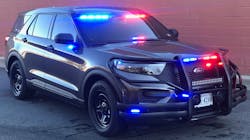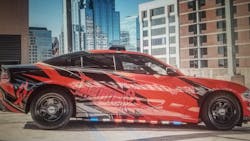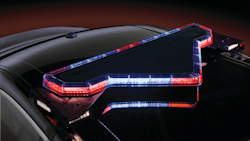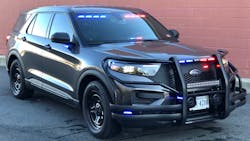Contemporary Emergency Equipment for Patrol
A few decades ago, lightbars were the only form of emergency lighting on a patrol vehicle aside from (maybe) a spotlight. Those early lightbars had one or two rotating lights that weren’t very bright, didn’t project very well, and rotated relatively slowly as compared to the more recent equivalents. Soon rotating lights were interspersed with multi-directional reflectors and the number of flashes per minute generated was increased almost two-fold. Attached to that increase in performance though, was an attached increase in maintenance cost. Lightbars became more expensive to manufacture and all of the moving parts had to be replaced as they wore out. The plastic lenses were produced in a variety of colors and they had to be maintained as well. (Old school officers will remember using Brasso to polish the lenses to keep them clear.)
One of the battles fought as lightbars evolved was to keep them from getting bigger and bigger alongside the development. Those bigger lightbars—as bright as they were and as many flashes per minute as they produced—they increased wind resistance and cost law enforcement agencies more money in fuel costs. They also made those patrol vehicles easier to spot when they were actually trying to be less easily seen during traffic enforcement or surveillance assignments. Of course, one response to this need was to create unmarked cars. No graphics. No stripes. No black and white color mix. Just a sedan with a single magnetically adhered rotator light that plugged into your cigarette lighter. Even equipped with a siren that made the cars less visible during emergency response.
Thankfully technology has evolved and brighter lights with smaller profiles have been developed. To prevent that rooftop lightbar drag and unwanted visibility challenge, lights were moved inside the vehicle along the top edge of the windshield, back window, rear deck in sedans, and in the marker/parking lights. With the development of sufficiently bright LED lights and digitally programmed flash patterns, being visible has never been easier, while at the same time, having your lights be low-profile is also easier than ever.
All of the major emergency lighting manufacturers make a variety of options for external, internal, LED and directional lightbars. The color mixes and specifications can be ordered to meet any agency’s requirements. Further, if the lightbars are internal mounting, they can be easily combined with auxiliary lighting mounted inside the vehicle facing other directions than front or rear, or in a variety of locations on the exterior of the vehicle.
The challenges that have to be met with all lighting designs are threefold. The first challenge is insuring that the projected light doesn’t negatively impact the officer’s vision and ability to observe his surroundings. The second challenge is insuring 360° visibility when the emergency lighting is activated. The final challenge is coordinating the emergency lights to work properly with both the officer’s duties and with the other equipment in or on the vehicle.
In the past, controls for activation of selected lights have been used to make the lights function in support of the officer and all back up officers who may respond to a given location. The variety of functions available were limited to the number of controls and the imagination of the installing personnel. With the added development of computer software and control integration, artificial intelligence now allows for the emergency lights to be used in a fashion that anticipates the officer’s needs and safety concerns.
With so much visibility and flexibility of function available and growing, the most valuable information an agency can have prior to equipping a patrol vehicle is knowing the needs of the agency for patrol and any specialized enforcement vehicles. Without a doubt, every marked patrol car needs to have highly visible 360° lighting. Whether the lights are all one color, mixed colors or incorporate standard warning/direction light colors (amber/yellow), the agency needs to have that identified and specified for the light acquisition.
If there is going to be auxiliary lighting in addition to the lightbar, that needs to be specified as well. Specify the power needs, connectivity and controls before the lights are procured. Once all of the lights, colors, desired flash patterns, etc. have been delineated, the control requirements specified, the variety of applications need to be considered and planned for. The same lights that provide excellent visibility from every angle can blind the officer as he exits his patrol vehicle, approaches it after contacting the driver on a traffic stop, or they can blind back up officers as they approach from the rear.
Thanks to modern technology, the value of artificial intelligence in lighting control is hard to measure. Emergency lights that are programmed to provide necessary lighting for the officer but also programmed to dim or shut off when they might blind the officer are a reality. One example comes from SoundOff Signal. Through the use of door sensors and software, the lightbar can be programmed so that even if the alley lights are on, when the officer opens the driver’s door, the lights on that end of the bar that would impair his vision are automatically turned off.
Having lightbars that can dim or turn off the rear facing lights, or the forward facing lights, depending on light sensor input contribute to officer survival and mitigating risk as the programming anticipates officer need and meets it automatically. What has to be taken into consideration is how those bright lights may impact the vision of other drivers. It’s long been known that a predictable and rhythmic flash pattern should be avoided. The flashes need to change pattern regularly, and the colors of the lights should rotate if possible as well. It’s vital to insure that all auxiliary lights are programmed to function properly with the main lightbar or other main emergency lighting system so that the same benefits of the main lighting are shared by the auxiliary lights. The same concerns for blinding the officer(s) and other drivers still exist.
The emergency sound systems have similar concerns that have to be specified and addresses. Turning off the sirens when an officer exits his vehicle should be automatic. At that point it’s far more important that s/he hear his radio than the siren, and not hearing the radio can be dangerous.
Final considerations for whole emergency sound and lighting packages are quantity and pricing. Survivability and longevity have to be taken into account so that the total value of such a package can be considered and not just the original purchase price. Today’s LED lightbars are much more durable and rugged than the older rotating incandescent systems, and even more visible now than strobe lights. In the end, what is required is the most visible system an agency can provide that never hinders or negatively impacts the officer’s duty performance and manages the agency’s long term cost most efficiently.

Lt. Frank Borelli (ret), Editorial Director | Editorial Director
Lt. Frank Borelli is the Editorial Director for the Officer Media Group. Frank brings 20+ years of writing and editing experience in addition to 40 years of law enforcement operations, administration and training experience to the team.
Frank has had numerous books published which are available on Amazon.com, BarnesAndNoble.com, and other major retail outlets.
If you have any comments or questions, you can contact him via email at [email protected].






